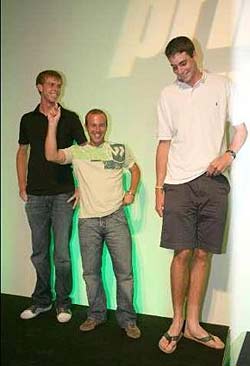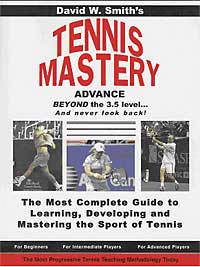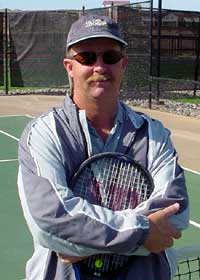|
TennisOne Lessons Does Size Matter? David W. Smith, Senior Editor TennisOne It would seem that the edge in professional tennis is leaning towards the “Goliaths” rather than the “Davids.” In both the ATP and WTA tours, the men and women who are emerging as contenders are reaching new heights… literally. It seemed a scene out of Gulliver’s Travels or the Bible’s first Samuel’s regarding the aforementioned David and Goliath reference where Olivier Rochus, standing all of 5 feet, 5 inches tall was shaking hands with 6-foot, 9-inch John Isner. When there is nearly a foot and a half difference between two players, it is not exactly a subtle difference.
It is more the exception than the rule today to have a competitive player near the top of the rankings as diminutive as Rochus, or even a Hewitt (at 5’11”), Santoro (also listed at 5’11”) or Arnaud Clement at (5’8”), Rochus’ latest opponent at the Pacific Life Open this week. In fact, it would have been the reverse just a couple decades ago, to find a contender who stood much over six feet, let alone six and a half feet. Such players who were far from being ‘vertically challenged’ were often discouraged from exploring tennis. Instead of putting a racquet in their hands, these genetically predispositioned players were far more likely to be given basketballs. The thinking back in the day was that tall players in tennis didn't have the athleticism to master the variety of touch, finesse and power-on-the-run that were requisite components of those who might reach the top echelon of the sport. Much like the once too tall six foot five basketball guard, these players were just too clumsy too compete. Funny how things change. Grinders Watching Clement and Rochus play is like watching two athletic women in the throws of giving birth. Smaller players exhibit seemingly unlimited endurance, efficiently breathing a cadence within any rally, especially long ones, on par with a pair of Lamaze birthing graduates. Because of their relatively smaller stature compared to their peers, guys like Rochus and Clement, as well as the smaller ladies on the WTA tour, (ie: Pratt, Mattek, Morigami, etc.), don’t carry the same mass and inertia that larger players can merge with more leverage from longer arms and legs.
From a spectator’s viewpoint, these smaller players create arguably more interesting matches due to the combination of less raw power and generally greater foot-speed. They often manufacture points the old-fashion way, using pinpoint placement, spin, and finesse to corner their opponent and end the point as a cat might finish off a cornered mouse. Today, we categorize these players as “Grinders” a term in tennis vernacular that conceptualizes a player who will stay in a point as long as it takes. As another tenacious grinder, Paul Goldstein, once said to me, "I need to establish at the beginning of a match that I'm willing to play a thirty ball rally to win a point. You can beat me, but you are going to have to work hard for it." Rochus and Clement’s match was a lot like that. One dicing slice was matched with an even lower one; a running forehand was answered with a magnificent running backhand, only to be retrieved and answered with a tender drop shot or well-placed approach. Big Guns But back to our Goliath-like players, the model today seems to be that of John, Isner, Ivo Karlovic, and Sam Querrey. Today, even these big guys can motor around the court fairly well. And obviously, size can matter; it is a lot easier hitting serves from a point nearly twelve feet above the ground and all of these guys can bring the serve. It is a little like how it feels when average teenagers hook up a pick up game of basketball on an elementary school basketball court. These kids probably feel like seven-footers, almost shooting down on the hoop. In tennis, having height can be advantageous, not only on serves but net play and overall lateral reach on the court. It is a delicate balance, like making the perfect wine or executing the perfect ice-skating program, to find the right tone of athleticism linked with a player who has height and reach.
As more true athletes from countries all over the world recognize the value of pursuing tennis as a career, it is inevitable that Darwinism will continue to control the evolution of our sport. Survival of the fittest is the name of the game in any sport. Defining “fittest” can be a little dicey today. Yet, it seems obvious that if you can infuse the attributes associated with those who are small—yet agile, quick, and finesseful—with those qualities associated with big and tall, you can create the perfect tennis animal. But, let us not devalue the importance of “Heart” in all players. We will always see exceptions to any rule. Those with the heart and soul, desire and drive, can often negate physical advantages in a given opponent and create the opportunity to defeat such players as certainly as David downed Goliath. In watching Rochus, you can feel intangibles he brings to the court - the heart and soul of a tennis warrior. And, while he may not be intimidating in stature, he certainly will make any player to work to beat him. And, whether or not we, ourselves, are gifted with size, or, perhaps like Rochus, with a lack of size, we should know that we are more limited by our perception of ourselves than anything else. Your comments are welcome. Let us know what you think about Dave Smith's article by emailing us here at TennisOne .
|


 Your comments are welcome. Let us know what you think about this article by
Your comments are welcome. Let us know what you think about this article by